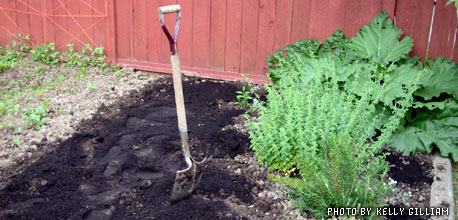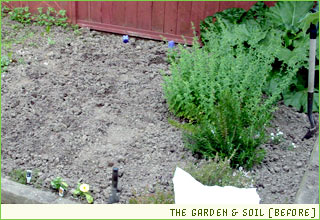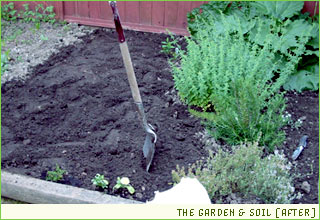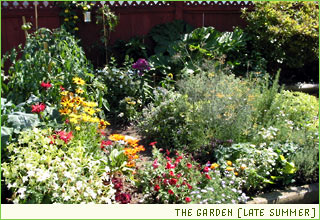 Guest post by Kelly Gilliam
Guest post by Kelly Gilliam
So you’ve just moved into a new place. You look around, and find yourself in a jam. Maybe your new yard doesn’t come with a garden plot, or perhaps the plot there is so overgrown with weeds that it looks like it hasn’t been touched in ten years. Whatever your situation, there’s no reason you can’t forge ahead and create your own sustainable and personal garden. All you need are some good tools, a little bit of research, and a plan for what you want to grow.
Last year I was presented with the problem of starting over, completely from scratch. After much prodding, my upstairs landlords had given me the okay to use a small, five-foot-square plot of land. They had left it unused and uncared for, apparently for the entire time they had owned the house. It baffled me that the clay-logged soil, infested with weeds, could ever have housed a working garden. Regardless, I was hell-bent on making my own little garden to grow not only hardy plants, but vegetables and more sensitive species as well.
I started by deciding exactly what it was that I wanted to grow. Being in love with the idea of one day growing all my own fruits and vegetables (to the point where I wouldn’t have to buy any save for the off-season), I decided the bulk of my plants would be vegetables and herbs. Luckily, my new plot received almost full sun and would be ideal for growing tomatoes, cucumbers, and herbs.
The next step was to break up the clay soil and add organic material to support the plants. Thankfully, I had recently bought Andy Sturgeon’s “Planted” and it proved to be an indispensable resource on soil types. At the time, I was working at a greenhouse so I was also able to learn from my co-workers. For my five by five foot area I settled on 30 L of mushroom manure, 60 L of topsoil and 20 Kg of washed sand. I dedicated a full day to re-conditioning my soil.
My first act in the plot was to rip out all of the larger weeds—anything over 15 cm in height or spread. I decided that I couldn’t rip out all of the smaller weeds, so I took my good, heavy-duty metal shovel and worked from one end to the other, turning over all the soil to break it up.
If there’s one nugget of wisdom I’d like to impart, it’s the value of getting yourself a good metal shovel. Plastic shovels, while cheaper, cannot take the strain of tough soil or tons of use (that goes for the handle as well the blade). It’s definitely worth the money to go all out on a good shovel; if you do you can get a life’s worth of use out of it.

For the next round of digging, I took the sand—all 20L of it—and threw it over the garden in segments, turning over each area with my shovel and a large metal-toothed rake as I went. I had decided that it was best to break up the clay with sand first, and then try to work in the organic material.
I worked in the mushroom manure using the same method I had with the sand. I chose mushroom manure not only to break up the soil, but also to add lots of nutrients. I did not want to be fertilizing every few weeks all summer, preferring to create something much more sustainable and low maintenance.
After I had finished with the manure I added the topsoil, to give the soil lots of bulk and more drainage. I had removed particularly large clumps of clay along the way and needed some filler for those areas.
When I was done, after nearly three hours, I was left with rich, dark soil that drained well but could also hold water on those long hot days when the plot would be in full sun. I was tired, but I was really excited that I had personalized my garden, and without even planting anything. I started to better understand that gardening all begins with the soil—that seems like such common knowledge, but it is easily overlooked in the haste and excitement of planning the look of a garden.

The next day I went to the greenhouse where I worked and picked up my vegetables, herbs and ornamentals. Because of the direct sun my garden would receive almost all-day, I made sure to pick lots of sun-loving plants. Tomatoes took up most of the room in my garden in the long run; my four baby plants eventually grew to over three feet tall and produced fruit constantly up until November, with no fertilizing. I planted several varieties of rudbeckia, as well as four types of basil, rosemary, dill, borage (a great herb with a cool cucumber flavour and beautiful little, blue, star-shaped flowers), fennel, cucumber, a lime plant, passionflower, and many other flowers. I also planted bee balm right beside my herbs and tomatoes to attract bees for pollination.

With a little research and a lot of persistence I had started from the ground up and made my own little garden according to my own tastes and needs. It took remarkably little of me save a few hours in the sun (with lots of sunscreen and water by my side), and I gained much from it. Not only did I have a garden, but I had created the area all myself and I really felt like it was my own. I had a bond with my garden that I’d never quite experienced before.
I’ve since moved from that basement suite into another urban basement suite, and that little plot is now somebody else’s. My current place doesn’t have any land of its own, but there is a perfect spot in the yard, calling my name, waiting to be transformed. I find myself really excited at the prospect of once again creating my own personal space.
Kelly is a city-dweller from Vancouver, B.C. Originally from the prairies, she was amazed to find that in Vancouver you can garden three-fourths of the year. She’s currently attending film school, and whenever she’s not in the stages of production she can be found digging around in her garden. She is also a photographer and her work can be viewed at Devileye.net.